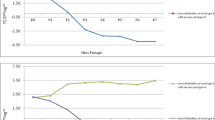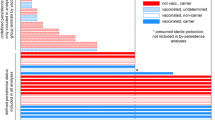Summary
-
1.
Fourteen of 30 vaccinated cattle became carriers of foot-and-mouth disease following exposure to virus Types A, O, and C. Nineteen of 32 unvaccinated cattle similarly exposed became carriers. A purified virus acetylethyleneimine-inactivated, oil adjuvant vaccine was used.
-
2.
No appreciable differences were observed among the 3 virus strains in the number of carriers produced or the virus titers of oesophageal-pharyngeal fluid. The number of carriers was lower than might be expected on the basis of previous studies using a strain isolated from carrier cattle.
-
3.
Previous work was confirmed by the finding that the immune status of the cattle exposed to the three strains did not prevent the establishment of the carrier state. Neither was there a demonstrable relationship between the presence of epithelial lesions and the development of the carrier state.
-
4.
Mean virus titers of oesophageal-pharyngeal fluid from vaccinated and unvaccinated carriers were of the same order.
Similar content being viewed by others
References
Augé de Mello, P., M. N. Honigman, andM. V. Fernandes: Supervivencia en bovinos del virus modificado de la fiebre aftosa. Presented at the 5th Pan American Congress of Veterinary Medicine and Zootechnics, Caracas, Venezuela (1966).
Bekkum, J. G. van, P. J. Straver, P. H. Bool, andS. Frenkel: Further information on the persistence of infective foot-and-mouth disease virus in cattle exposed to virulent virus strains. Presented at the O.I.E. Meeting in Paris (1966).
Burrows, R.: Observations on the carrier state following exposure to foot-and-mouth disease virus. Presented at the Annual Meeting of the European Commission for the Control of Foot-and-Mouth Disease (Standing Technical Committee) held at the Animal Virus Research Institute, Pirbright, England (14–16 September 1966).
Cottral, G. E., B. F. Cox, andD. E. Baldwin: The survival of foot-and-mouth disease virus in cured and uncured meat. Amer. J. vet. Res.21, 288–297 (1960).
Cunha, R. G., J. R. Baptista, Jr., U. M. Serrao eI. Torturella: El uso de los ratones lactantes en la evaluacion de los anticuerpos contra el virus de la fiebre su significacion immunologica. Gac. vet. (B. Aires)19, 243–267 (1957).
Graves, J. H.: Foot-and-mouth disease vaccine: Immune response of cattle to different inactivated serotype antigens in monovalent and trivalent mixtures. In preparation.
Graves, J. H., P. D. McKereher, H. E. Farris, Jr., andK. M. Cowan: Early response of cattle and swine to inactivated foot-and-mouth disease vaccine. Res. Vet. Sci.9, 35–40 (1968).
Hedger, R. S.: The isolation and characterization of foot-and-mouth disease virus from clinically normal herds of cattle in Botswana. J. Hyg. (Lond.)66, 27–36 (1968).
McKercher, P. D., R. W. Dellers, andA. R. Giordano: Foot-and-mouth disease infection in cattle housed in an isolation unit. Cornell Vet.56, 395–421 (1966).
Sutmoller, P., P. Augé de Mello, M. H. Honigman, andK. E. Federer: Infectivity for cattle and pigs of three strains of foot-and-mouth disease virus isolated from carrier cattle. Amer. J. vet. Res.28, 101–105 (1967).
Sutmoller, P., andG. E. Cottral: Improved techniques for the detection of foot-and-mouth disease virus in carrier cattle. Arch. ges. Virusforsch.21, 170–177 (1967).
Sutmoller, P., J. W. McVicar, andG. E. Cottral: The epizootiological importance of foot-and-mouth disease carriers. I. Experimentally produced foot-and-mouth disease carriers in susceptible and immune cattle. Arch. ges. Virusforsch.23, 227–235 (1968).
Author information
Authors and Affiliations
Rights and permissions
About this article
Cite this article
McVicar, J.W., Sutmoller, P. The epizootiological importance of foot-and-mouth disease carriers. Archiv f Virusforschung 26, 217–224 (1969). https://doi.org/10.1007/BF01242374
Received:
Issue Date:
DOI: https://doi.org/10.1007/BF01242374




